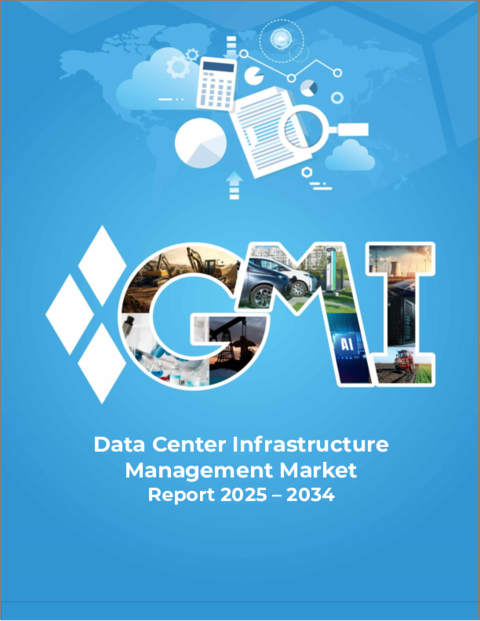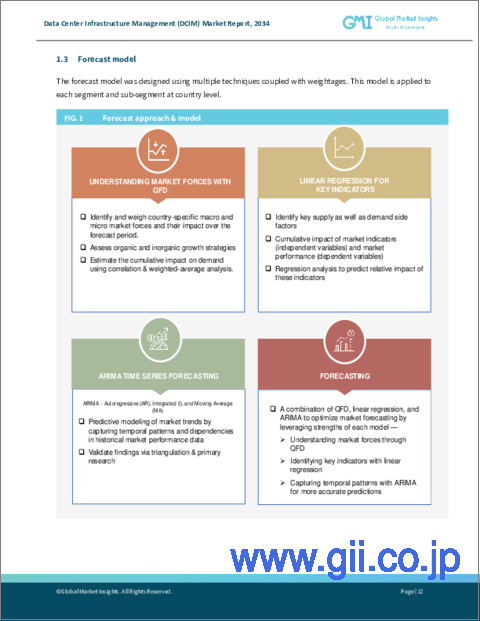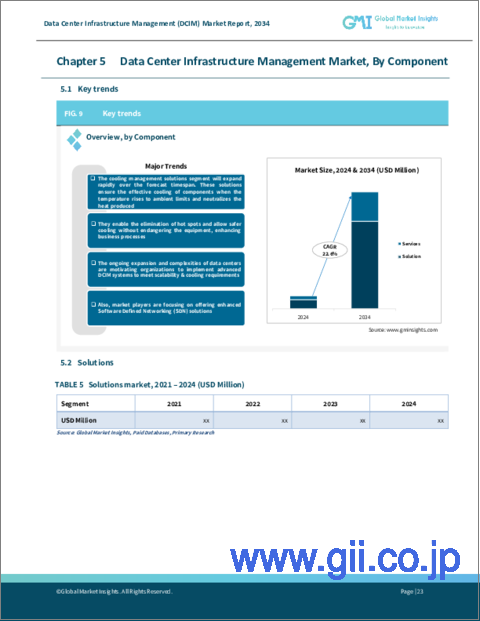|
|
市場調査レポート
商品コード
1628024
データセンターインフラ管理市場の市場機会、成長促進要因、産業動向分析、2025~2034年予測Data Center Infrastructure Management (DCIM) Market Opportunity, Growth Drivers, Industry Trend Analysis, and Forecast 2025 to 2034 |
||||||
カスタマイズ可能
|
|||||||
| データセンターインフラ管理市場の市場機会、成長促進要因、産業動向分析、2025~2034年予測 |
|
出版日: 2024年11月15日
発行: Global Market Insights Inc.
ページ情報: 英文 180 Pages
納期: 2~3営業日
|
全表示
- 概要
- 目次
世界のデータセンターインフラ管理(DCIM)市場は、2024年に42億米ドルと評価され、2025年から2034年にかけてCAGR 22.6%で堅調に拡大すると予測されています。
この急成長の主な要因は、データセンターにおけるエネルギー効率の重視の高まりです。これらの施設はエネルギーの大量消費者であるため、コスト管理と環境負荷の低減のために電力使用の最適化が不可欠となっています。
DCIMソリューションは、データセンター内のエネルギー消費を監視・管理するための重要なツールを提供し、オペレータが非効率を特定し、データ駆動型の改善戦略を実施できるようにします。これらのソリューションは、電力利用率の向上、運用の合理化、厳しい環境規制の遵守を促進します。DCIMは、電力と冷却システムに対するリアルタイムの洞察を提供することで、運用効率を維持しながら持続可能性の目標を達成できるよう支援します。
市場はコンポーネント別にソリューションとサービスに区分されます。2024年には、ソリューション部門が市場シェアの70%を占め、2034年までに250億米ドルを創出すると予測されています。このセグメントの優位性は、電力使用量の最適化、冷却管理、資産追跡のための統合ツールを通じて、インフラ管理の主要課題に対処できることに起因しています。デジタル経済の拡大に伴い、データセンターは効率的な拡張を迫られており、包括的なDCIMソリューションへの需要がさらに高まっています。
| 市場範囲 | |
|---|---|
| 開始年 | 2024 |
| 予測年 | 2025-2034 |
| 開始金額 | 42億米ドル |
| 予測金額 | 334億米ドル |
| CAGR | 22.6% |
エンドユーザー別では、コロケーション、BFSI、エネルギー、政府、ヘルスケア、製造、IT&テレコム、その他のセクターに分類されます。BFSIセグメントは2024年の市場の24%を占める。BFSI分野における堅牢なインフラストラクチャの必要性は、大量の機密データを扱うことに起因しており、アップタイム、セキュリティ、コンプライアンスが最重要課題となっています。DCIMツールは、金融機関が運用を最適化し、インフラの信頼性を向上させ、中断のないサービス提供を保証するのに役立っています。
米国のデータセンターインフラ管理(DCIM)市場は、2024年に地域別シェアの75%を占め、2034年までに100億米ドルを創出すると予測されています。このリーダーシップの原動力となっているのは、米国の高度な技術エコシステムと、さまざまなデジタルサービスをサポートするデータセンターの急増です。大手クラウドサービスプロバイダーの存在と厳格なデータセキュリティ規制が、DCIMの採用をさらに加速させています。
全体として、DCIM市場は、急速に拡大するデジタルランドスケープにおける運用効率、エネルギー最適化、コンプライアンスの必要性に後押しされ、変革的な成長を遂げています。持続可能で信頼性の高いデータセンター運用の推進により、DCIMは最新のITインフラ管理の重要な実現要素として位置づけられています。
目次
第1章 調査手法と調査範囲
第2章 エグゼクティブサマリー
第3章 業界洞察
- エコシステム分析
- サプライヤーの状況
- DCIMソリューションプロバイダー
- DCIMサービスプロバイダー
- ソフトウェア開発業者
- ネットワークインフラ・プロバイダー
- システムインテグレーターと再販業者
- 利益率分析
- DCIMソリューションのコスト内訳
- テクノロジーとイノベーションの展望
- 主要ニュースとイニシアチブ
- 規制状況
- 影響要因
- 促進要因
- エネルギー効率と持続可能性への需要の高まり
- クラウドコンピューティングとデータトラフィックの増加
- IoTとエッジコンピューティングの採用増加
- データセンターのアップタイムと運用効率の改善ニーズ
- 業界の潜在的リスク&課題
- 高い初期コストと複雑な実装
- 既存のデータセンターインフラとの統合の問題
- 促進要因
- 成長可能性分析
- ポーター分析
- PESTEL分析
第4章 競合情勢
- イントロダクション
- 企業シェア分析
- 競合のポジショニング・マトリックス
- 戦略展望マトリックス
第5章 市場推計・予測:コンポーネント別、2021年~2034年
- 主要動向
- ソリューション
- 資産管理
- ネットワーク管理
- 冷却管理
- 電力・温度管理
- セキュリティ管理
- サービス
- 設置と統合
- マネージド
- コンサルティング
第6章 市場推計・予測:エンドユーザー別、2021年~2034年
- 主要動向
- コロケーション
- BFSI
- エネルギー
- 政府機関
- ヘルスケア
- 製造業
- IT・通信
- その他
第7章 市場推計・予測:地域別、2021年~2034年
- 主要動向
- 北米
- 米国
- カナダ
- 欧州
- 英国
- ドイツ
- フランス
- スペイン
- イタリア
- ロシア
- 北欧
- アジア太平洋
- 中国
- インド
- 日本
- 韓国
- ニュージーランド
- 東南アジア
- ラテンアメリカ
- ブラジル
- メキシコ
- アルゼンチン
- 中東・アフリカ
- アラブ首長国連邦
- 南アフリカ
- サウジアラビア
第8章 企業プロファイル
- ABB
- Cisco Systems
- Commscope Holding Company
- Cormant
- Dell
- Delta Electronics
- Hewlett Packard Enterprise Company
- Huawei Technologies
- IBM Corporation
- Infosys
- Modius
- Nlyte Software
- NTT Data
- Panduit
- Raritan
- Rittal
- Reichle & De-Massari
- Schneider Electric
- Siemens
- Stulz
The Global Data Center Infrastructure Management (DCIM) Market was valued at USD 4.2 billion in 2024 and is forecasted to expand at a robust CAGR of 22.6% from 2025 to 2034. This rapid growth is primarily driven by the increasing emphasis on energy efficiency in data centers. As these facilities are significant energy consumers, optimizing power usage has become essential to manage costs and reduce environmental impact.
DCIM solutions provide critical tools for monitoring and managing energy consumption within data centers, enabling operators to identify inefficiencies and implement data-driven strategies for improvement. These solutions facilitate enhanced power utilization, streamlined operations, and adherence to stringent environmental regulations. By offering real-time insights into power and cooling systems, DCIM helps organizations achieve their sustainability goals while maintaining operational efficiency.
The market is segmented by components into solutions and services. In 2024, the solution segment captured 70% of the market share and is projected to generate USD 25 billion by 2034. This segment's dominance is attributed to its ability to address key infrastructure management challenges through integrated tools for power usage optimization, cooling management, and asset tracking. As the digital economy expands, data centers are under pressure to scale efficiently, further increasing the demand for comprehensive DCIM solutions.
| Market Scope | |
|---|---|
| Start Year | 2024 |
| Forecast Year | 2025-2034 |
| Start Value | $4.2 Billion |
| Forecast Value | $33.4 Billion |
| CAGR | 22.6% |
By end-use, the market is categorized into sectors such as colocation, BFSI, energy, government, healthcare, manufacturing, IT & telecom, and others. The BFSI segment accounted for 24% of the market in 2024. The need for robust infrastructure in the BFSI sector stems from its handling of large volumes of sensitive data, where uptime, security, and compliance are paramount. DCIM tools empower financial organizations to optimize operations, enhance infrastructure reliability, and ensure uninterrupted service delivery.
U.S. data center infrastructure management (DCIM) market held 75% of the regional share in 2024, with projections to generate USD 10 billion by 2034. This leadership is driven by the nation's advanced technology ecosystem and the proliferation of data centers supporting a wide array of digital services. The presence of major cloud service providers and stringent data security regulations further accelerate DCIM adoption.
Overall, the DCIM market is experiencing transformative growth fueled by the need for operational efficiency, energy optimization, and compliance in a rapidly expanding digital landscape. The push for sustainable and reliable data center operations positions DCIM as a critical enabler of modern IT infrastructure management.
Table of Contents
Chapter 1 Methodology & Scope
- 1.1 Research design
- 1.1.1 Research approach
- 1.1.2 Data collection methods
- 1.2 Base estimates and calculations
- 1.2.1 Base year calculation
- 1.2.2 Key trends for market estimates
- 1.3 Forecast model
- 1.4 Primary research & validation
- 1.4.1 Primary sources
- 1.4.2 Data mining sources
- 1.5 Market definitions
Chapter 2 Executive Summary
- 2.1 Industry 360° synopsis, 2021 - 2034
Chapter 3 Industry Insights
- 3.1 Industry ecosystem analysis
- 3.2 Supplier landscape
- 3.2.1 DCIM solution providers
- 3.2.2 DCIM service providers
- 3.2.3 Software developers
- 3.2.4 Network infrastructure providers
- 3.2.5 System integrators and resellers
- 3.3 Profit margin analysis
- 3.4 Cost breakdown of DCIM solutions
- 3.5 Technology & innovation landscape
- 3.6 Key news & initiatives
- 3.7 Regulatory landscape
- 3.8 Impact forces
- 3.8.1 Growth drivers
- 3.8.1.1 Increasing demand for energy efficiency and sustainability
- 3.8.1.2 Growth in cloud computing and data traffic
- 3.8.1.3 Rising adoption of IoT and edge computing
- 3.8.1.4 Need for improved data center uptime and operational efficiency
- 3.8.2 Industry pitfalls & challenges
- 3.8.2.1 High initial costs and complex implementation
- 3.8.2.2 Integration issues with existing data center infrastructure
- 3.8.1 Growth drivers
- 3.9 Growth potential analysis
- 3.10 Porter's analysis
- 3.11 PESTEL analysis
Chapter 4 Competitive Landscape, 2024
- 4.1 Introduction
- 4.2 Company market share analysis
- 4.3 Competitive positioning matrix
- 4.4 Strategic outlook matrix
Chapter 5 Market Estimates & Forecast, By Component, 2021 - 2034 ($Bn)
- 5.1 Key trends
- 5.2 Solution
- 5.2.1 Asset management
- 5.2.2 Network management
- 5.2.3 Cooling management
- 5.2.4 Power and temperature management
- 5.2.5 Security management
- 5.3 Services
- 5.3.1 Installation & integration
- 5.3.2 Managed
- 5.3.3 Consulting
Chapter 6 Market Estimates & Forecast, By End-Use, 2021 - 2034 ($Bn)
- 6.1 Key trends
- 6.2 Colocation
- 6.3 BFSI
- 6.4 Energy
- 6.5 Government
- 6.6 Healthcare
- 6.7 Manufacturing
- 6.8 IT & Telecom
- 6.9 Others
Chapter 7 Market Estimates & Forecast, By Region, 2021 - 2034 ($Bn)
- 7.1 Key trends
- 7.2 North America
- 7.2.1 U.S.
- 7.2.2 Canada
- 7.3 Europe
- 7.3.1 UK
- 7.3.2 Germany
- 7.3.3 France
- 7.3.4 Spain
- 7.3.5 Italy
- 7.3.6 Russia
- 7.3.7 Nordics
- 7.4 Asia Pacific
- 7.4.1 China
- 7.4.2 India
- 7.4.3 Japan
- 7.4.4 South Korea
- 7.4.5 ANZ
- 7.4.6 Southeast Asia
- 7.5 Latin America
- 7.5.1 Brazil
- 7.5.2 Mexico
- 7.5.3 Argentina
- 7.6 MEA
- 7.6.1 UAE
- 7.6.2 South Africa
- 7.6.3 Saudi Arabia
Chapter 8 Company Profiles
- 8.1 ABB
- 8.2 Cisco Systems
- 8.3 Commscope Holding Company
- 8.4 Cormant
- 8.5 Dell
- 8.6 Delta Electronics
- 8.7 Hewlett Packard Enterprise Company
- 8.8 Huawei Technologies
- 8.9 IBM Corporation
- 8.10 Infosys
- 8.11 Modius
- 8.12 Nlyte Software
- 8.13 NTT Data
- 8.14 Panduit
- 8.15 Raritan
- 8.16 Rittal
- 8.17 Reichle & De-Massari
- 8.18 Schneider Electric
- 8.19 Siemens
- 8.20 Stulz






